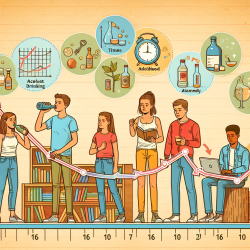Introduction
As practitioners dedicated to fostering positive outcomes for children, understanding the developmental trajectories of adolescent behaviors is crucial. A recent study titled "Discrete time measures versus trajectories of drinking frequency across adolescence as predictors of binge drinking in young adulthood: a longitudinal investigation" provides valuable insights into how adolescent drinking patterns can predict future binge drinking behaviors. This blog explores the implications of these findings for practitioners and encourages further research in this area.
Key Findings from the Study
The study followed 1,293 high-school students from ages 12 to 24, analyzing their drinking behaviors using group-based trajectory modeling. The researchers identified seven distinct drinking trajectories, ranging from 'late triers' to 'early frequent drinkers'. The study found that early drinking behaviors, particularly those starting before age 13, significantly increased the likelihood of sustained binge drinking in young adulthood.
Key predictors of sustained binge drinking included:
- Frequency of drinking at age 12
- Frequency of drinking at age 17
- Age at drinking onset
- Age at onset of drinking monthly or more often
Implications for Practitioners
For practitioners working with adolescents, these findings underscore the importance of early intervention. Identifying at-risk youth through simple screening measures can facilitate timely interventions that may prevent the progression to harmful drinking patterns in adulthood. Practitioners are encouraged to incorporate questions about drinking frequency and onset age into routine assessments.
Encouraging Further Research
While the study provides a robust framework for understanding adolescent drinking trajectories, there are still gaps that need exploration. Future research could focus on:
- Developing and validating screening tools for early identification of at-risk youth
- Investigating the role of environmental and social factors in shaping drinking trajectories
- Exploring intervention strategies tailored to specific trajectory groups
Conclusion
Understanding the developmental pathways of adolescent drinking behaviors is crucial for preventing adverse outcomes in adulthood. By leveraging the insights from this study, practitioners can enhance their screening and intervention efforts, ultimately supporting healthier developmental trajectories for adolescents.
To read the original research paper, please follow this link: Discrete time measures versus trajectories of drinking frequency across adolescence as predictors of binge drinking in young adulthood: a longitudinal investigation.










